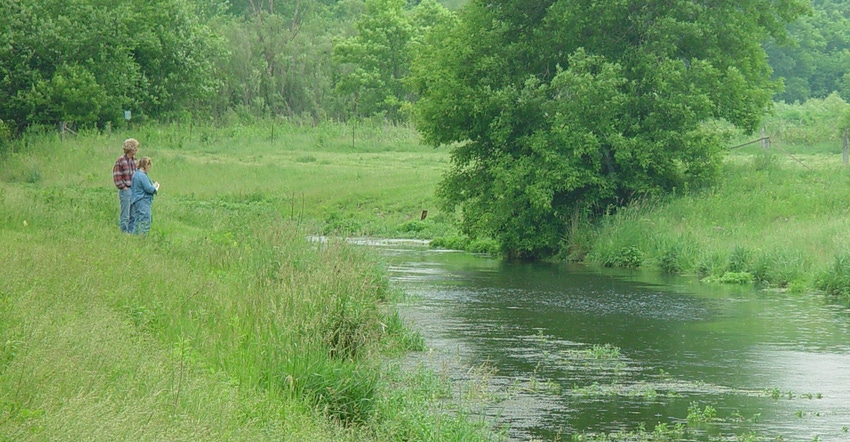February 28, 2019

Farmers in Iowa’s Missouri-Little Sioux watershed are increasingly using best management practices recommended by the Iowa Nutrient Reduction Strategy, according to a new study by Iowa State University. The study was released early this year.
The study is part of the ongoing Iowa Nutrient Reduction Strategy (NRS) Farmer Survey, which aims to measure change in Iowa farmers’ knowledge and attitudes related to the Iowa Nutrient Reduction Strategy and their use of best management practices. Farmers in the Missouri-Little Sioux watershed, which covers the northwest and west-central areas of Iowa, were surveyed in 2015 and 2016.
Making progress, but long way to go
Because one of the survey’s goals is to track progress toward the NRS, farmers were asked how long they had been using key practices. Most farmers reported having used many of the more established practices such as terraces and buffers along streams for more than three years. Among practices that have been promoted heavily by the NRS for their effectiveness, substantial percentages of farmers reported more recent adoption.
Among users of cover crops, 56% had started using them in the previous three years. Similarly, 27% of farmers who reported using contour buffer strips and 20% of variable-rate nitrogen users said they began using the practices in the previous three years.
Additionally, farmers expressed increased interest in potential future use of other best management practices. Between 2015 and 2016, the percentage of farmers indicating they might use sidedress fertilizer application in the future increased from 22% to 35%. The proportion indicating they might use extended crop rotations increased from 14% to 21%, and those who considered using bioreactors increased from 10% to 17%.
Only 15% use cover crops
“These results show that many farmers in the watershed have started using key practices such as cover crops since the Nutrient Reduction Strategy started, and those who aren’t using them are increasingly open to the possibility,” says J. Arbuckle, ISU Extension rural sociologist and co-author of the report. “That represents progress, but there’s still a long way to go. For example, just 15% of farmers in the watershed reported using cover crops.”
Between 2015 and 2016, farmers reported no significant change in the knowledge of the Iowa Nutrient Reduction Strategy or in their attitudes related to water quality and the strategy. However, the sources of information from which farmers learned about the strategy experienced some change. In 2015, 48% of farmers learned about the strategy from commodity or farm organizations; 54% learned from these sources in 2016, representing a statistically significant increase.
“Commodity groups have placed emphasis on communicating with their members about the [Iowa Nutrient Reduction Strategy] and nutrient loss reduction, and these results indicate that those efforts have been effective,” says Laurie Nowatzke, coordinator for the NRS and co-author of the report. “Still, there is opportunity for various partners to more effectively conduct outreach with farmers in the Missouri-Little Sioux watershed. These findings are useful as we measure progress toward meeting the goals of the strategy and identify areas that may require additional information, outreach and resources.”
Additional survey findings include:
In the Missouri-Little Sioux hydrologic unit code (HUC6) watershed, 31% of farmers reported they were knowledgeable or very knowledgeable about the NRS, and 28% reported slight or no knowledge.
The farm press, ISU Extension and conservation agencies were the most common sources of information about the strategy.
Pressure to make profit margins and lack of economic resources, including cost share and landlords’ unwillingness to invest in conservation, were increasingly cited as substantial barriers to conservation practice adoption.
The percentage of farmers citing lack of knowledge about best management practices as a barrier to adoption of those practices declined significantly, indicating that farmers are learning more about BMPs.
Full results of the survey can be found in ISU Extension publication Iowa Farmers and the Iowa Nutrient Reduction Strategy: Survey Results from the Missouri-Little Sioux Watershed, SOC 3087.
The Iowa Nutrient Reduction Strategy Farmer Survey is a five-year study that surveys a random sample of farmers in a new Iowa six-digit HUC6 and a random sample of repeat respondent farmers from a previously surveyed HUC6 watershed each year. Future reports will highlight results from these watersheds: Upper Mississippi-Maquoketa-Plum, Iowa River, Des Moines River, Missouri-Nishnabotna River, and Upper Mississippi-Skunk-Wapsipinicon River.
Source: Iowa State University, which is responsible for the information provided and is wholly owned by the source. Informa Business Media and its subsidiaries aren’t responsible for any of the content contained in this information asset.
You May Also Like




